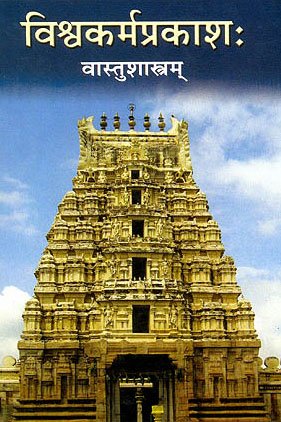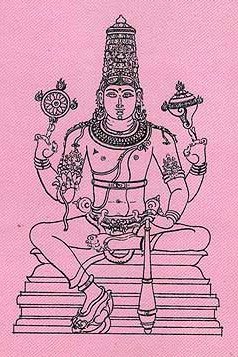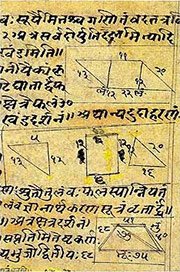Nripa, Nṛpa, Nri-pa: 21 definitions
Introduction:
Nripa means something in Hinduism, Sanskrit, Jainism, Prakrit, the history of ancient India, Marathi, Hindi. If you want to know the exact meaning, history, etymology or English translation of this term then check out the descriptions on this page. Add your comment or reference to a book if you want to contribute to this summary article.
The Sanskrit term Nṛpa can be transliterated into English as Nrpa or Nripa, using the IAST transliteration scheme (?).
Alternative spellings of this word include Nrap.
In Hinduism
Arthashastra (politics and welfare)
Source: Shodhganga: Kakati Ganapatideva and his times (artha)Nṛpa (नृप, “king”) represents one of the members that makes up the jury of a law court, according to Brihaspati. The king should appoint brāhmaṇas who were reputed scholars of Vedas, Dharma-śāstras and truthful and free from ariṣaḍvargas (six evils of human beings). Ketana and Śukra points out that the king or the chief justice should be assisted by a panel of three or five or seven jurors

Arthashastra (अर्थशास्त्र, arthaśāstra) literature concerns itself with the teachings (shastra) of economic prosperity (artha) statecraft, politics and military tactics. The term arthashastra refers to both the name of these scientific teachings, as well as the name of a Sanskrit work included in such literature. This book was written (3rd century BCE) by by Kautilya, who flourished in the 4th century BCE.
Purana and Itihasa (epic history)
Source: archive.org: Shiva Purana - English TranslationNṛpa (नृप) refers to “kings”, as mentioned in the Śivapurāṇa 2.2.27. Accordingly as Brahmā narrated to Nārada:—“[...] once a great sacrifice was started by Dakṣa, [...] Brahminical, Royal and celestial sages, kings (nṛpa), with their friends, ministers, armies etc, Vasus and other chief Gaṇadevatas—all of them were invited by him in the sacrifice”.

The Purana (पुराण, purāṇas) refers to Sanskrit literature preserving ancient India’s vast cultural history, including historical legends, religious ceremonies, various arts and sciences. The eighteen mahapuranas total over 400,000 shlokas (metrical couplets) and date to at least several centuries BCE.
Jyotisha (astronomy and astrology)
Source: Wisdom Library: Brihat Samhita by VarahamihiraNṛpa (नृप) refers to a “sovereign”, according to the Bṛhatsaṃhitā (chapter 4), an encyclopedic Sanskrit work written by Varāhamihira mainly focusing on the science of ancient Indian astronomy astronomy (Jyotiṣa).—Accordingly, “If the two horns of the moon should appear but slightly raised and far from each other presenting the appearance of a boat, she brings trouble on the sailors but prosperity on mankind at large. [...] If, on the first lunar day after new moon, both horns should be alike and of equal height, there will be the same prosperity and rain throughout the month as on such first lunar day. If the moon should appear like a rod, the cattle will suffer and the sovereign [i.e., nṛpa] will rule with a severe rod”.

Jyotisha (ज्योतिष, jyotiṣa or jyotish) refers to ‘astronomy’ or “Vedic astrology” and represents the fifth of the six Vedangas (additional sciences to be studied along with the Vedas). Jyotisha concerns itself with the study and prediction of the movements of celestial bodies, in order to calculate the auspicious time for rituals and ceremonies.
Vastushastra (architecture)
Source: Brill: Śaivism and the Tantric Traditions (architecture)Nṛpa (नृप) refers to the “king”, according to the Devyāmata (chapter 105).—Accordingly, [while describing the consequences of a doorway]—“Thus, in due sequence, the consequences of doorways are given. [With a doorway] at Īśa, the householder will have the risk of fire; at Parjanya, harm from women. At Jaya [the householder] is endowed with wealth. At Māhendra he is dear to the king (nṛpa-vallabha). At Āditya there is anger. At Satya there is lawful conduct. [...]”.

Vastushastra (वास्तुशास्त्र, vāstuśāstra) refers to the ancient Indian science (shastra) of architecture (vastu), dealing with topics such architecture, sculpture, town-building, fort building and various other constructions. Vastu also deals with the philosophy of the architectural relation with the cosmic universe.
Pancaratra (worship of Nārāyaṇa)
Source: University of Vienna: Sudarśana's Worship at the Royal Court According to the AhirbudhnyasaṃhitāNṛpa (नृप) refers to a “ruler”, according to the Ahirbudhnyasaṃhitā, belonging to the Pāñcarātra tradition which deals with theology, rituals, iconography, narrative mythology and others.—Accordingly, “A ruler (nṛpa) who is a Universal Sovereign is entitled to the first, a Provincial Governor to the second and a District Governor to the third [level of] Creative Energy. [To the same are entitled] a chief minister or a twice-born, provided he is in charge of the protection of many people. No single man is entitled to [deploy] Her for [just] another man”.

Pancaratra (पाञ्चरात्र, pāñcarātra) represents a tradition of Hinduism where Narayana is revered and worshipped. Closeley related to Vaishnavism, the Pancaratra literature includes various Agamas and tantras incorporating many Vaishnava philosophies.
Ganitashastra (Mathematics and Algebra)
Source: archive.org: Hindu MathematicsNṛpa (नृप) represents the number 16 (sixteen) in the “word-numeral system” (bhūtasaṃkhyā), which was used in Sanskrit texts dealing with astronomy, mathematics, metrics, as well as in the dates of inscriptions and manuscripts in ancient Indian literature.—A system of expressing numbers by means of words arranged as in the place-value notation was developed and perfected in India in the early centuries of the Christian era. In this system the numerals [e.g., 16—nṛpa] are expressed by names of things, beings or concepts, which, naturally or in accordance with the teaching of the Śāstras, connote numbers.

Ganitashastra (शिल्पशास्त्र, gaṇitaśāstra) refers to the ancient Indian science of mathematics, algebra, number theory, arithmetic, etc. Closely allied with astronomy, both were commonly taught and studied in universities, even since the 1st millennium BCE. Ganita-shastra also includes ritualistic math-books such as the Shulba-sutras.
Ayurveda (science of life)
Toxicology (Study and Treatment of poison)
Source: Shodhganga: Kasyapa Samhita—Text on Visha ChikitsaNṛpa (नृप) (or Āragvadha) is the name of an ingredient used in the treatment of Maṇḍalī-snake-bites, according to the Kāśyapa Saṃhitā: an ancient Sanskrit text from the Pāñcarātra tradition dealing with both Tantra and Viṣacikitsā—an important topic from Āyurveda which deals with the study of Toxicology (Viṣavidyā or Sarpavidyā).—A number of different permutation and combination of herbs are prescribed as Lepa and Pāna for removing the poison of Maṇḍalī snakes.—According to the Kāśyapasaṃhitā verse 9.78cd: “Cūrṇa or powder of betel leaves, curd, layer of Āragvadha or Nṛpa tree and three hand fulls of salt (or a type of grass) when smeared on the bite-wound, quickly destroys the poison”.

Āyurveda (आयुर्वेद, ayurveda) is a branch of Indian science dealing with medicine, herbalism, taxology, anatomy, surgery, alchemy and related topics. Traditional practice of Āyurveda in ancient India dates back to at least the first millenium BC. Literature is commonly written in Sanskrit using various poetic metres.
In Jainism
General definition (in Jainism)
Source: The University of Sydney: A study of the Twelve ReflectionsNṛpa (नृप) refers to “kings”, according to the 11th century Jñānārṇava, a treatise on Jain Yoga in roughly 2200 Sanskrit verses composed by Śubhacandra.—Accordingly, “Snakes, fire, poison, tigers, elephants, lions, demons and kings (nṛpa), etc. do not hurt those whose selves are settled in the doctrine. On the earth even the lord of the snakes with a thousand trembling mouths is not able to describe clearly the entire power of the doctrine”.

Jainism is an Indian religion of Dharma whose doctrine revolves around harmlessness (ahimsa) towards every living being. The two major branches (Digambara and Svetambara) of Jainism stimulate self-control (or, shramana, ‘self-reliance’) and spiritual development through a path of peace for the soul to progess to the ultimate goal.
India history and geography
Source: Cologne Digital Sanskrit Dictionaries: Indian Epigraphical GlossaryNṛpa.—(IE 7-1-2), ‘sixteen’. Note: nṛpa is defined in the “Indian epigraphical glossary” as it can be found on ancient inscriptions commonly written in Sanskrit, Prakrit or Dravidian languages.

The history of India traces the identification of countries, villages, towns and other regions of India, as well as mythology, zoology, royal dynasties, rulers, tribes, local festivities and traditions and regional languages. Ancient India enjoyed religious freedom and encourages the path of Dharma, a concept common to Buddhism, Hinduism, and Jainism.
Languages of India and abroad
Marathi-English dictionary
Source: DDSA: The Molesworth Marathi and English Dictionarynṛpa (नृप) [or नृपति, nṛpati].—m (S) A king.
Source: DDSA: The Aryabhusan school dictionary, Marathi-Englishnṛpa (नृप) [or nṛpati, or नृपति].—m A king.
Marathi is an Indo-European language having over 70 million native speakers people in (predominantly) Maharashtra India. Marathi, like many other Indo-Aryan languages, evolved from early forms of Prakrit, which itself is a subset of Sanskrit, one of the most ancient languages of the world.
Sanskrit dictionary
Source: DDSA: The practical Sanskrit-English dictionaryNṛpa (नृप).—&c. See under नृ (nṛ).
See also (synonyms): nṛpati, nṛpāla.
--- OR ---
Nṛpa (नृप).—[nṝn pāti rakṣati, pā-ka] a ruler of men, king, sovereign; चतुर्योजनपर्यन्तमधिकारो नृपस्य च (caturyojanaparyantamadhikāro nṛpasya ca) Brav. P. (śrīkṛṣṇajanmakhaṇḍe). °अंशः (aṃśaḥ)
1) royal portion of revenue, i. e. a sixth, eighth &c. part of grain; काले नृपाशं विहितं ददद्भिः (kāle nṛpāśaṃ vihitaṃ dadadbhiḥ) Bhaṭṭikāvya 2.14.
2) a prince. °अङ्गनम् (aṅganam) (ṇam) a royal court. °अध्वरः (adhvaraḥ) Name of a sacrifice (Rājasūya) performed by an emperor or lord paramount, in which all the offices are performed by tributary princes. °आत्मजः (ātmajaḥ) a prince, crown-prince. °आभीरम्, °मानम् (ābhīram, °mānam) music played at the royal meals. °आमयः (āmayaḥ) consumption. °आसनम् (āsanam) 'royal-seat', a throne, the chair of state. °गृहम् (gṛham) a royal palace. °द्रुमः (drumaḥ) Name of some trees (Mār. bāhavā, rāṃjaṇī). °नीतिः (nītiḥ) f. politics, royal policy, state-craft; वेश्याङगनेव नृपनीतिरनेकरूपा (veśyāṅaganeva nṛpanītiranekarūpā) Bhartṛhari 2.47. °प्रियः (priyaḥ) the mango tree. °लक्ष्मन् (lakṣman) n., लिङ्गम् (liṅgam) a royal symbol, an emblem of royalty, any one of the royal insignia; particularly, the white umbrella. °लिङ्गधर (liṅgadhara) a.
1) assuming the insignia of royalty.
2) assuming the royal insignia (as a disguise). °वल्लभः (vallabhaḥ)
1) the friend or favourite of a king.
2) a kind of mango.
-bhā a queen. °शासनम् (śāsanam) a royal grant or edict. °संश्रय (saṃśraya) a. seeking the protection of a king. °सुता (sutā) the musk-rat. °सभम्, सभा (sabham, sabhā) an assembly of kings.
Derivable forms: nṛpaḥ (नृपः).
Nṛpa is a Sanskrit compound consisting of the terms nṛ and pa (प).
--- OR ---
Nṛpa (नृप).—
1) a king; जाताभिषङ्गो नृपतिः (jātābhiṣaṅgo nṛpatiḥ) R.2.3; विद्वत्वं च नृपत्वं च नैव तुल्यं कदाचन (vidvatvaṃ ca nṛpatvaṃ ca naiva tulyaṃ kadācana) Subhāṣ.
2) Name of Kubera.
3) Kṣatriya. °पथः (pathaḥ) a royal or main road. °संश्रयः (saṃśrayaḥ)
1) royal support; नृपसंश्रयमिष्यते जनैः (nṛpasaṃśrayamiṣyate janaiḥ) Pt.
2) service of princes.
Derivable forms: nṛpaḥ (नृपः).
Nṛpa is a Sanskrit compound consisting of the terms nṛ and pa (प). See also (synonyms): nṛpati, nṛpāla.
Source: Cologne Digital Sanskrit Dictionaries: Shabda-Sagara Sanskrit-English DictionaryNṛpa (नृप).—m.
(-paḥ) A king, a sovereign. E. nṛ man, pā to protect, aff. ka.
Source: Cologne Digital Sanskrit Dictionaries: Benfey Sanskrit-English DictionaryNṛpa (नृप).—[nṛ-pa] (vb. 2. pā), A prince, a king, [Mānavadharmaśāstra] 2, 139.
Source: Cologne Digital Sanskrit Dictionaries: Monier-Williams Sanskrit-English Dictionary1) Nṛpa (नृप):—[=nṛ-pa] [from nṛ] a See p.568.[column]2.
2) [=nṛ-pa] [from nṛ] b m. (√3. pā) protector of men, prince, king, sovereign, [Śāṅkhāyana-śrauta-sūtra; Manu-smṛti; Mahābhārata] etc.
3) [v.s. ...] (in music) a kind of measure
4) [v.s. ...] Name of the numeral 16 [Gaṇitādhyāya]
Source: Cologne Digital Sanskrit Dictionaries: Yates Sanskrit-English DictionaryNṛpa (नृप):—[nṛ-pa] (paḥ) 1. m. A king.
Source: DDSA: Paia-sadda-mahannavo; a comprehensive Prakrit Hindi dictionary (S)Nṛpa (नृप) in the Sanskrit language is related to the Prakrit word: Ṇiva.
[Sanskrit to German]
Sanskrit, also spelled संस्कृतम् (saṃskṛtam), is an ancient language of India commonly seen as the grandmother of the Indo-European language family (even English!). Closely allied with Prakrit and Pali, Sanskrit is more exhaustive in both grammar and terms and has the most extensive collection of literature in the world, greatly surpassing its sister-languages Greek and Latin.
Hindi dictionary
Source: DDSA: A practical Hindi-English dictionaryNṛpa (नृप) [Also spelled nrap]:—(nm) a king, monarch.
...
Kannada-English dictionary
Source: Alar: Kannada-English corpusNṛpa (ನೃಪ):—[noun] a male monarch of a major territorial unit, esp. one whose position is hereditary and who rules for life; a king.
Kannada is a Dravidian language (as opposed to the Indo-European language family) mainly spoken in the southwestern region of India.
See also (Relevant definitions)
Starts with (+94): Nripabadara, Nripabadari, Nripabala, Nripabhaga, Nripabhaya, Nripabhira, Nripabhushani, Nripacakshu, Nripachakshu, Nripacihna, Nripadana, Nripadharma, Nripadhvara, Nripadi, Nripadipa, Nripadruma, Nripadvish, Nripadvishta, Nripagriha, Nripahani.
Ends with: Anripa, Bharatanripa, Dirghanripa, Durnripa, Harinripa, Krishna nripa, Kunripa, Madananripa, Mukhyanripa, Naimishanripa, Nandananripa, Pradeshinripa, Punyadhyanripa, Shrenikanripa, Simhanripa, Sphitanripa, Sunripa, Udananripa.
Full-text (+234): Nripapriya, Nripamandira, Nripaniti, Nripalinga, Nripasamshraya, Nripati, Nripadruma, Nripamana, Nripatva, Nripalingadhara, Nripapriyaphala, Durnripa, Nripamaya, Nripavallabha, Nripasuta, Nripamjaya, Nripadhvara, Nripalakshman, Nripakriyamkri, Nripakanda.
Relevant text
Search found 41 books and stories containing Nripa, Nṛpa, Nri-pa, Nrpa, Nṛ-pa, Nr-pa; (plurals include: Nripas, Nṛpas, pas, Nrpas). You can also click to the full overview containing English textual excerpts. Below are direct links for the most relevant articles:
Garga Samhita (English) (by Danavir Goswami)
Verse 1.14.64 < [Chapter 14 - The Liberation of Śakaṭāsura and Tṛṇāvarta]
Verse 4.5.7 < [Chapter 5 - The Story of the Ayodhyā Women]
Verse 5.1.4 < [Chapter 1 - Advice to Kaṃsa]
Manusmriti with the Commentary of Medhatithi (by Ganganatha Jha)
Verse 8.309 < [Section XLIII - Theft (steya)]
Verse 7.73 < [Section VI - Fortification (durga)]
Verse 7.174 < [Section XII - Daily Routine of Work]
Vishnudharmottara Purana (Art and Architecture) (by Bhagyashree Sarma)
6. Materials for Colours Used in Painting < [Chapter 5 - Painting and Image Making]
1.3. Elements of Drama (a): Acting < [Chapter 3 - Drama and Dance]
1.3. Elements of Drama (f): Dramatic Style < [Chapter 3 - Drama and Dance]
Bhakti-rasamrta-sindhu (by Śrīla Rūpa Gosvāmī)
Verse 1.2.60 < [Part 2 - Devotional Service in Practice (sādhana-bhakti)]
Verse 2.3.8 < [Part 3 - Involuntary Ecstatic Expressions (sattvika-bhāva)]
Verse 1.2.31 < [Part 2 - Devotional Service in Practice (sādhana-bhakti)]
Mudrarakshasa (literary study) (by Antara Chakravarty)
6. Subhāśitas occuring in Mudrārākṣasa < [Chapter 5 - Adoption of Style and Language in Mudrārākṣasa]
Brihad Bhagavatamrita (commentary) (by Śrī Śrīmad Bhaktivedānta Nārāyana Gosvāmī Mahārāja)
Verse 1.1.60 < [Chapter 1 - Bhauma (the earthly plane)]
Verse 1.5.129 < [Chapter 5 - Priya (the beloved devotees)]
Verse 1.1.59 < [Chapter 1 - Bhauma (the earthly plane)]